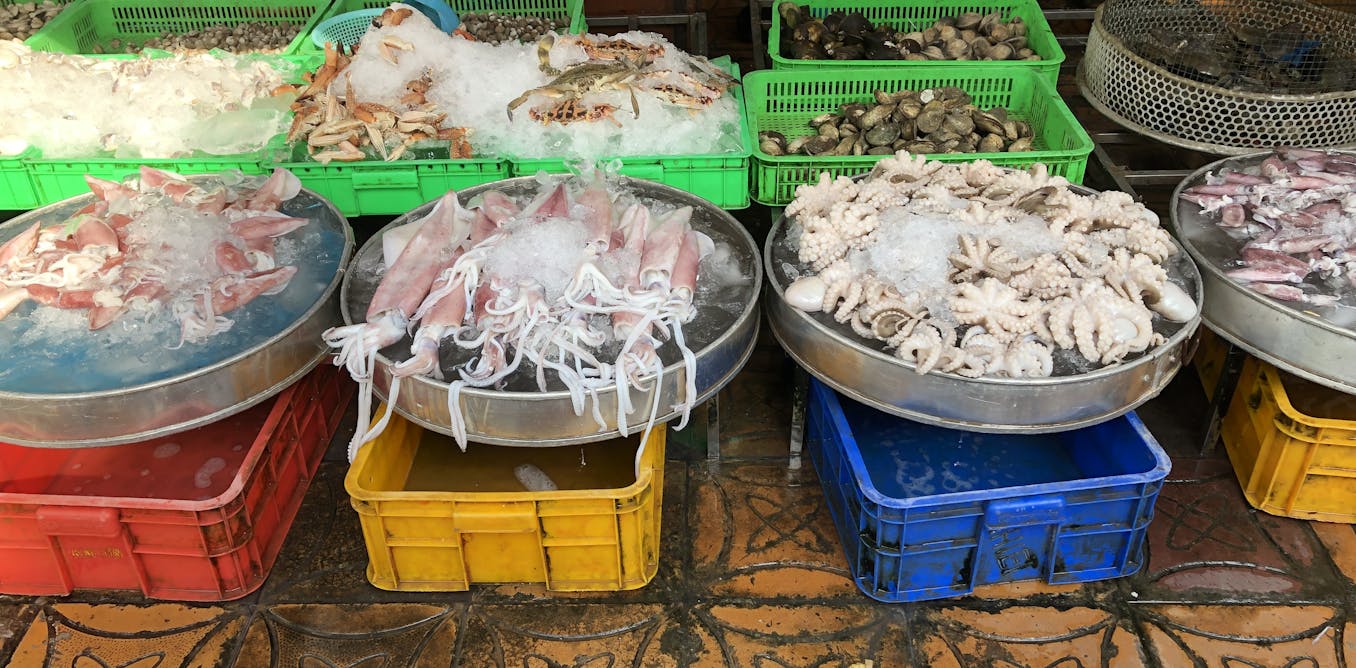Food safety policy neglects informal markets in developing countries – 3 ways this can change
Food safety policy neglects informal markets in developing countries ... The Conversation


The Challenges of Food Safety in the Informal Sector

The food industry in many low- and middle-income countries is dominated by the informal sector. Numerous micro and small businesses, which are not legally registered and mostly compete on the basis of price, handle much of the food that people eat. This includes meat, fish, and fresh fruit and vegetables. Informal businesses also dominate when it comes to out-of-home eating.
Fresh foods are important vectors of food-borne diseases, chemical contaminants, and other hazards. But in the informal sector, there are widespread deficiencies in food safety awareness and in the way food is stored, prepared, and handled. Hygiene is not always good at places where vendors work. Consumers are mainly focused on price and have limited ability to protect themselves from unsafe foods.
The informal sector therefore poses great challenges for food safety.
Food Safety Risks in the Informal Sector
We recently published a report that looked at food safety risks in the informal sector of developing countries. Our report suggests that food sourced through informal markets accounts for 80% of cases of food-borne disease in low-income countries. In lower middle-income countries, the proportion is 65%.
There has been growing attention on food safety in low- and middle-income countries by governments and international development agencies. Our report shows, however, there’s a big policy blind spot in this area. Most food safety initiatives focus on medium or larger food manufacturers, elements of the so-called “modern retail”, food exports, and commercial farms or better organized smallholder producers. Also, most attention is given to upgrading national food safety regulations.
The informal sector is typically given minimal attention. There are exceptions. But most efforts to upgrade the food handling practices of informal food vendors have had only short-lived impacts and are not scalable. The need for traditional food markets to be upgraded and for the capacity of towns and cities to regulate informal food businesses are glaring omissions.
We conclude in our report that tackling the food safety problem in low- and middle-income countries requires a fundamental shift in thinking and practice. Actions towards improving food safety must be implemented by local governments and municipalities where informal markets are based. There must be synergies with other goals and interventions, for example, the provision of safe water and improved sanitation. And government agencies need to balance incentives and deterrents better when trying to get informal food businesses to use better food safety practices.
Informal Markets
The continued dominance of the informal sector in low- and middle-income countries might be considered a transitional issue that will naturally go away with time. That is, food will become safer as economic development proceeds, food systems change, and governments become better at food safety regulation.
Certainly, we have seen supermarkets and other “modern” forms of food distribution emerge in the major cities of these countries. However, food system formalization takes time. In poorer countries, in particular, informal markets and the traditional operators that work there will continue to dominate for many years. Further, diet and demographic changes in these countries are increasing consumer exposure to food safety hazards, especially as they eat more fresh foods.
On top of this, while significant resources have gone into strengthening national food safety agencies in some countries, the impact on the informal sector has been minimal. Central government agencies typically have little regular contact with the informal sector, and even less influence over it.
The informal sector is often an afterthought when low- and middle-income countries look to upgrade their food safety controls. Worse, it is seen as a legacy of the past, not fitting with the national vision of a modern, competitive, and resilient food system. Government officials ignore many informal food businesses. Or worse, they do what they can to make them go away, for example, by disrupting their commerce or imposing draconian fines.
Tailored Solutions
Much of the food safety problem is a natural consequence of the limited capacity and weak incentives of informal food businesses. Sustainable improvements are needed to address both issues simultaneously.
Local circumstances, including market and administrative structures, and the state of physical infrastructure, vary greatly. There are also variations in the risk profile of different types of informal businesses, be they market sellers, micro food processors, or street food vendors. A “one size fits all” approach won’t do. Solutions need to be customized to local conditions and to the targeted players.
Three fundamental shifts are needed to achieve greater and more sustained progress towards safer food in low- and middle-income countries.
- The epicenter of attention needs to shift from central to local governments.
- The focus should be on multisectoral interventions.
- Regulation of the informal sector by government agencies should be reset.
It is municipal governments that interact with informal food businesses and influence the conditions in which they operate. These include access to clean water and sanitation and the physical condition of markets. Municipalities lay down most of the controls on the activities of local food businesses. Central governments need to empower local governments to act, giving them the legal authority and resources they need, and laying down frameworks for local action and for sharing experiences.
The focus should be on multisectoral interventions that could combine food safety with attention to animal health, environmental health, nutrition, safe water, and sanitation. Stand-alone food safety projects and programs may not be the best way to mobilize and use resources in the informal sector.
Regulation of the informal sector by government agencies should be reset. It should aim to enable gradual and sustained improvements in food safety practices. Government officials should mainly provide advice and support services and be rewarded on the basis of incremental food safety improvements. Regulatory enforcement will still be needed but should be the last resort.
SDGs, Targets, and Indicators
-
SDG 2: Zero Hunger
- Target 2.1: By 2030, end hunger and ensure access by all people, in particular the poor and people in vulnerable situations, including infants, to safe, nutritious and sufficient food all year round.
- Indicator 2.1.2: Prevalence of moderate or severe food insecurity in the population, based on the Food Insecurity Experience Scale (FIES).
-
SDG 3: Good Health and Well-being
- Target 3.2: By 2030, end preventable deaths of newborns and children under 5 years of age, with all countries aiming to reduce neonatal mortality to at least as low as 12 per 1,000 live births and under-5 mortality to at least as low as 25 per 1,000 live births.
- Indicator 3.2.2: Under-5 mortality rate.
-
SDG 6: Clean Water and Sanitation
- Target 6.1: By 2030, achieve universal and equitable access to safe and affordable drinking water for all.
- Indicator 6.1.1: Proportion of population using safely managed drinking water services.
-
SDG 8: Decent Work and Economic Growth
- Target 8.3: Promote development-oriented policies that support productive activities, decent job creation, entrepreneurship, creativity and innovation, and encourage the formalization and growth of micro-, small- and medium-sized enterprises, including through access to financial services.
- Indicator 8.3.1: Proportion of informal employment in non-agriculture employment, by sex.
-
SDG 12: Responsible Consumption and Production
- Target 12.3: By 2030, halve per capita global food waste at the retail and consumer levels and reduce food losses along production and supply chains, including post-harvest losses.
- Indicator 12.3.1: Food loss index.
Table: SDGs, Targets, and Indicators
| SDGs | Targets | Indicators |
|---|---|---|
| SDG 2: Zero Hunger | Target 2.1: By 2030, end hunger and ensure access by all people, in particular the poor and people in vulnerable situations, including infants, to safe, nutritious and sufficient food all year round. | Indicator 2.1.2: Prevalence of moderate or severe food insecurity in the population, based on the Food Insecurity Experience Scale (FIES). |
| SDG 3: Good Health and Well-being | Target 3.2: By 2030, end preventable deaths of newborns and children under 5 years of age, with all countries aiming to reduce neonatal mortality to at least as low as 12 per 1,000 live births and under-5 mortality to at least as low as 25 per 1,000 live births. | Indicator 3.2.2: Under-5 mortality rate. |
| SDG 6: Clean Water and Sanitation | Target 6.1: By 2030, achieve universal and equitable access to safe and affordable drinking water for all. | Indicator 6.1.1: Proportion of population using safely managed drinking water services. |
| SDG 8: Decent Work and Economic Growth | Target 8.3: Promote development-oriented policies that support productive activities, decent job creation, entrepreneurship, creativity and innovation, and encourage the formalization and growth of micro-, small- and medium-sized enterprises, including through access to financial services. | Indicator 8.3.1: Proportion of informal employment in non-agriculture employment, by sex. |
| SDG 12: Responsible Consumption and Production | Target 12.3: By 2030, halve per capita global food waste at the retail and consumer levels and reduce food losses along production and supply chains, including post-harvest losses. | Indicator 12.3.1: Food loss index. |
Analysis
The issues highlighted in the article are connected to several Sustainable Development Goals (SDGs), including SDG 2: Zero Hunger, SDG 3: Good Health and Well-being, SDG 6: Clean Water and Sanitation, SDG 8: Decent Work and Economic Growth, and SDG 12: Responsible Consumption and Production.
Based on the content of the article, specific targets under these SDGs can be identified:
- Under SDG 2: Target 2.1 aims to end hunger and ensure access to safe, nutritious, and sufficient food all year round. The prevalence of moderate or severe food insecurity in the population, as measured by the Food Insecurity Experience Scale (FIES), can be used as an indicator to measure progress towards this target.
- Under SDG 3: Target 3.2 aims to end preventable deaths of newborns and children under 5 years of age. The under-5 mortality rate can be used as an indicator to measure progress towards this target.
- Under SDG 6: Target 6.1 aims to achieve universal access to safe and affordable drinking water for all. The proportion of the population using safely managed drinking water services can be used as an indicator to measure progress towards this target.
- Under SDG 8: Target 8.3 aims to promote decent job creation and the formalization of micro-, small-, and medium-sized enterprises. The proportion of informal employment in non-agriculture employment, by sex, can be used as
Behold! This splendid article springs forth from the wellspring of knowledge, shaped by a wondrous proprietary AI technology that delved into a vast ocean of data, illuminating the path towards the Sustainable Development Goals. Remember that all rights are reserved by SDG Investors LLC, empowering us to champion progress together.
Source: theconversation.com

Join us, as fellow seekers of change, on a transformative journey at https://sdgtalks.ai/welcome, where you can become a member and actively contribute to shaping a brighter future.







